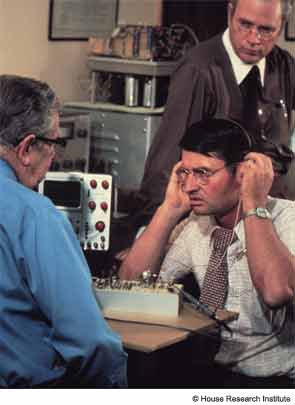
Critical Junctures in Cochlear Implant Development
1957—Paris: Eyriès implants Djourno’s coils; alternating current transmitted to the coil produces perception of sound.
1960-61—Los Angeles: House and Doyle begin work on prosthesis; effect electrical stimulation during stapes surgery; implant three patients with a single gold electrode.
1964—Palo Alto, Calif.: Simmons, at Stanford, develops a six-electrode system using a percutaneous plug.
1969-70—Los Angeles: House implants first hardwire five-electrode system in three patients.
1970-71—San Francisco: Michelson and colleagues at UC San Francisco implant three patients using a gold two-electrode system; Michelson and Bartz work with four patients and perform bipolar scala tympani procedure, efforts that would later coalesce into Advanced Bionics.
1972—Los Angeles: First wearable CI device and first induction system, using a centering coil and attaching magnet, are developed by House’s team.
1973-76—Paris: Chouard pioneers the 12-electrode array.
1974—San Francisco: First International Conference on Electrical Stimulation of the Acoustic Nerve.
1977-78—Vienna: Team led by Hochmair designs and manufactures a passive single-channel broadband analog implant, efforts that later lead to the founding of MED-EL.
1977—Washington, DC: Patent granted to Adam Kissiah, a NASA engineer who first described the conversion process by which electronic stimuli are detected by the acoustic nerve and interpreted by the brain as meaningful sound patterns.
1977—Washington, DC: Publication of the Bilger Report, produced by a team of researchers at the University of Pittsburgh, which lent credibility to efficacy of CIs and led to NIH research support.
1978—Melbourne, Australia: Clark and colleagues develop multi-channel prototype with an array of 20 electrodes, efforts that would later lead to the founding of Cochlear Ltd., a branch of Nucleus, manufacturer of heart pacemakers.
1978—Los Angeles, Indiana and other sites: first multi-center trial of cochlear implants.
1984—Silver Spring, Md.: FDA approves the House/3M single-channel implant for adults.
1987-2000—Silver Spring, Md.: FDA approves multiple-channel implant for adults (1987), multiple-channel CI for children 2 years of age and older (1990), multiple channel for children 18 months and older (1998) and multiple channel for infants 1 year of age (2000).
Early 1990s—Los Angeles: Robert V. Shannon, MD, and colleagues develop a noise band vocoder that simulates CI processing, discovering that four bands of modulated noise are sufficient to allow high levels of speech understanding (Science. 1995;270:303-304).
Leave a Reply